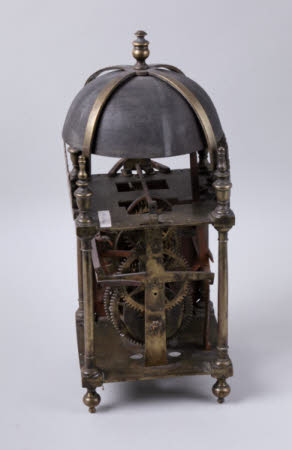Lantern clock
Category
Horology
Date
1700 - 1800
Materials
Brass, iron and steel.
Measurements
380 mm (Height)
Order this imageCollection
Hill Top, Cumbria
NT 641793
Summary
Lantern clock, brass, visible workings, square base with short baluster legs, domed bell with baluster finial, missing its face, English, about 1650-1700.
Full description
This object is part of the collection at Hill Top. Beatrix Potter purchased this farmhouse and working farm in the Lake District village of Near Sawrey in 1905, using the profits from her books. After her marriage to William Heelis in 1913, Beatrix relocated permanently to Sawrey. The couple made nearby Castle Cottage their home, but Beatrix spent as much time as she could at Hill Top. As well as a space for work and creativity – and the location for many of her famous tales – it became an intensely personal sanctuary for her. Beatrix knew exactly how she would decorate Hill Top and she arranged its interiors carefully and deliberately. She wrote: ‘I would have old furniture…it is not as expensive as modern furniture, and incomparably handsomer…’ Once she had renovated the farmhouse, she filled it with examples of local furniture and treasured heirlooms, like her grandmother’s warming pan and a set of plates decorated with designs by her father. The object is a lantern clock, which is an early form without a pendulum. Many of its parts, including the clock face, are missing, but this doesn’t seem to have spoiled Beatrix’s enjoyment of the object. She describes the clock in a letter written to an American friend, Bertha Maloney Miller, on the 23rd August 1943. Bertha was the founder and editor of ‘The Horn Book’, a magazine dedicated to children’s literature – they also shared an interest in furniture and antiques. Beatrix writes: ‘My lantern clock had a curious history. A man in Ulverston who buys secondhand furniture at sales bought a long case [clock] at an auction. When he got it home and looked inside, he found this much older brass clock was fixed in, in such a way as to use the face and fingers of the grandfather. I bought the old one which he pulled out; unfortunately its own face is missing. It has the brass dome which was the bell and the pretty pierced brass fret, with dolphins, which is usually considered about 1650-70.’
References
Crowell-Morse 1982: Jane Crowell-Morse (ed.), Beatrix Potter's Americans. Boston: Horn Books, 1982. , p. 201
